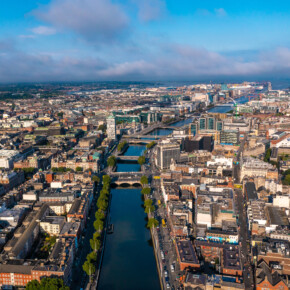Dublin Airport wants change to night hours
Padraig Conlon 07 Jan 2021
Dublin Airport operator daa has lodged an application to change conditions connected to the operation of the new North Runway and the overall runway system at the airport.
daa say they want to change what it claims are “onerous conditions” for the hours during which it can operate.
They have lodged an application to amend two planning conditions due to apply to the new North Runway and the overall runway system at Dublin Airport.
The current conditions would limit the use of North Runway between 11pm and 7am and also place an overall limit of 65 aircraft movements across the entire airport during those hours.
If unchanged, these two conditions would significantly affect the operation of the airport and its key airline customers and would damage the entire Irish economy.
Under the planning application lodged recently, daa is proposing the introduction of a noise quota system at night, which is the industry standard approach for managing night-time noise at large airports.
This proposed new quota system would operate between 11.30pm and 6am.
daa is also proposing that North Runway would only be used between 6am and midnight, meaning that there would be no flights on the new runway during the core midnight to 6am night-time hours.
“We had originally wanted to have these two onerous conditions removed entirely,” said daa Chief Executive Dalton Philips,
“But having engaged with the local community and listened to their views we have revised our previous position and are now proposing very significant mitigation measures.”
Under daa’s new proposals the overall effects of night-time noise at Dublin Airport are less than envisaged under the planning permission granted in 2007, and do not exceed those in 2018.
Within the planning application, daa is also proposing a new €7 million insulation scheme for dwellings that are most affected by night-time noise.
The proposed scheme would see grants of €20,000 paid to the owners of up to 350 eligible houses.
daa has already established an insulation programme for about 200 local households and has established a voluntary scheme to purchase up to 38 properties that will be most affected by the operation of the North Runway at a significant premium to their market value if the runway was not being built.
“The new proposal balances the requirements of the Irish economy with the valid concerns of the local community,” according to Mr Philips.
Being able to have a flexible operation in the peak 6am-7am window is essential for the economy given that Ireland is one hour behind continental Europe.
Mr Philips said the proposed new measures would provide Dublin Airport with “the operational flexibility that is required to help the Irish economy recover from the impact of COVID-19 and face the challenges of a post-Brexit environment, while ensuring that the effects of night-time noise that were envisaged by the original planning conditions are not exceeded”.
The original planning conditions, which date from the grant of planning permission in 2007, placed an overall limit of 65 aircraft movements across the entire airport campus between 11pm and 7pm.
However, last year even before the addition of North Runway, there was an average of about 100 aircraft movements during this time period.
A noise quota system, which already applies at airports such as Heathrow, Brussels and Madrid, would limit the overall amount of noise generated by aircraft and, in tandem with the other proposed measures, would limit the effects of night-time operations at Dublin Airport.
Under this system, the number of aircraft operating within the night-time window may vary, but the overall effects of noise from those aircraft would be capped. This incentivises airlines to use quieter aircraft at Dublin Airport.
“The number of planes is the wrong measure, the focus should be on the amount and effects of noise,” according to Mr Philips.
The planning application, which relates to the mode of operation of the new runway, notes that there are no significant environmental effects as a result of the proposals.
Modern aircraft are significantly more fuel efficient than when the runway planning application was submitted about 15 years ago, and new aircraft types are delivering further efficiency gains.
The mix of air traffic means that with larger aircraft, and higher seat occupancy rates, the number of overall flight movements at Dublin Airport is much less than had been expected when planning for the new runway was originally granted.











